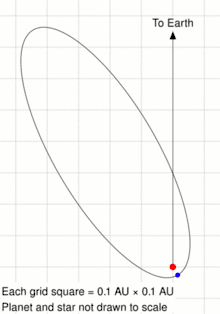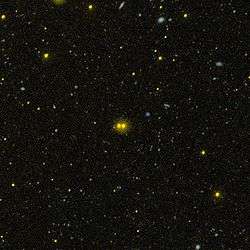HD 80606 and HD 80607
HD 80606 and HD 80607 are two stars comprising a binary star system. They are approximately 217 light-years away in the constellation of Ursa Major. Both stars orbit each other at an average distance of 1,200 astronomical units. The binary system is listed as Σ1341 in the Struve Catalogue of Double Stars, however this designation is not in wide use and the system is usually referred to by the HD designations of its constituent stars. An extrasolar planet has been confirmed to orbit HD 80606 in a highly elliptical orbit.
| Observation data Epoch J2000.0 Equinox J2000.0 | |
|---|---|
| Constellation | Ursa Major |
| HD 80606 | |
| Right ascension | 09h 22m 37.5769s[1] |
| Declination | +50° 36′ 13.430″[1] |
| Apparent magnitude (V) | +9.00[2] |
| HD 80607 | |
| Right ascension | 09h 22m 39.7369s[3] |
| Declination | +50° 36′ 13.945″[3] |
| Apparent magnitude (V) | +9.090[4] |
| Characteristics | |
| HD 80606 | |
| Spectral type | G5[5] |
| B−V color index | +0.765[5] |
| HD 80607 | |
| Spectral type | G5[5] |
| B−V color index | +0.828[5] |
| Astrometry | |
| HD 80606 | |
| Radial velocity (Rv) | 3.6 km/s |
| Proper motion (μ) | RA: 55.933[1] mas/yr Dec.: 10.340[1] mas/yr |
| Parallax (π) | 15.0153 ± 0.0361[1] mas |
| Distance | 217.2 ± 0.5 ly (66.6 ± 0.2 pc) |
| HD 80607 | |
| Radial velocity (Rv) | 3.3 km/s |
| Proper motion (μ) | RA: 52.624 mas/yr Dec.: 9.945 mas/yr |
| Parallax (π) | 15.0474 ± 0.0341[3] mas |
| Distance | 216.8 ± 0.5 ly (66.5 ± 0.2 pc) |
| Details | |
| HD 80606 | |
| Surface gravity (log g) | 4.50 ± 0.20[6] cgs |
| Temperature | 5645 ± 45[6] K |
| Metallicity [Fe/H] | 0.43 ± 0.06[6] dex |
| Rotational velocity (v sin i) | 0.9 ± 0.6[6] km/s |
| HD 80607 | |
| Surface gravity (log g) | 4.52 ± 0.15[6] cgs |
| Temperature | 5555 ± 45[6] K |
| Metallicity [Fe/H] | 0.38 ± 0.06[6] dex |
| Rotational velocity (v sin i) | 1.4 ± 0.4[6] km/s |
| Other designations | |
| HD 80606: HIP 45982, SAO 27230 | |
| HD 80607: HIP 45983 | |
| Database references | |
| SIMBAD | HD 80606 |
| HD 80607 | |
Planetary system

The variable radial velocity of HD 80606 was first noticed in 1999 from observations with the 10-m Keck 1 telescope at the W. M. Keck Observatory in Hawaii by the G-Dwarf Planet Search, a survey of nearly 1000 nearby G dwarfs to identify extrasolar planet candidates. The star was then followed up by the Geneva Extrasolar Planet Search team using the ELODIE spectrograph mounted on the 1.93-m telescope at the Haute-Provence Observatory. The discovery of HD 80606 b was announced on April 4, 2001.[7][6] Its orbit is misaligned with the star's rotation at 53 degrees.[8][9] Additional studies using the Spitzer Space Telescope in the infrared, and the Very Large Array in the millimeter radio, have shown that the highly eccentric planet 'b' orbiting HD 80606 grazes the parent star at its closest passage to produce difficult-to-detect stellar lobing, severe 'space weather', aurorae and other non-thermal activity.[10][11][12]
At the time, its orbit was the most eccentric orbit of any extrasolar planet known.[note 1] It has an eccentricity of 0.9336,[5] comparable to that of Comet Halley in the Solar System. The eccentricity may be a result of the Kozai mechanism, which would occur if the planet's orbit is significantly inclined to that of the binary stars. This conclusion is reinforced by the detection of the misalignment, an expected result of the Kozai mechanism.[8]
In a simulation of a 10 million year span, the planet "sweeps clean" most test particles within 1.75 AU of HD 80606. The 8:1 resonance hollows out another Kirkwood gap at 1.9 AU. There cannot be any habitable planets in this system. Also, observation has ruled out planets heavier than 0.7 Jupiter mass with a period of one year or less.[13]
| Companion (in order from star) |
Mass | Semimajor axis (AU) |
Orbital period (days) |
Eccentricity | Inclination | Radius |
|---|---|---|---|---|---|---|
| b | 4.0 ± 0.3[8] MJ | 0.453 ± 0.015[8] | 111.436 ± 0.003[8] | 0.9336 ± 0.0002[5] | 89.285 ± 0.023[5]° | 0.987 ± 0.061[9] RJ |
See also
References
- Brown, A. G. A.; et al. (Gaia collaboration) (August 2018). "Gaia Data Release 2: Summary of the contents and survey properties". Astronomy & Astrophysics. 616. A1. arXiv:1804.09365. Bibcode:2018A&A...616A...1G. doi:10.1051/0004-6361/201833051. Gaia DR2 record for this source at VizieR.
- Høg, E.; et al. (2000). "The Tycho-2 catalogue of the 2.5 million brightest stars". Astronomy and Astrophysics. 355: L27–L30. Bibcode:2000A&A...355L..27H.
- Brown, A. G. A.; et al. (Gaia collaboration) (August 2018). "Gaia Data Release 2: Summary of the contents and survey properties". Astronomy & Astrophysics. 616. A1. arXiv:1804.09365. Bibcode:2018A&A...616A...1G. doi:10.1051/0004-6361/201833051. Gaia DR2 record for this source at VizieR.
- Kharchenko, N. V.; et al. (2007). "Astrophysical supplements to the ASCC-2.5: Ia. Radial velocities of ~55000 stars and mean radial velocities of 516 Galactic open clusters and associations". Astronomische Nachrichten. 328 (9): 889. arXiv:0705.0878. Bibcode:2007AN....328..889K. doi:10.1002/asna.200710776.
- Fossey, S. J.; et al. (2009). "Detection of a transit by the planetary companion of HD 80606". Monthly Notices of the Royal Astronomical Society: Letters. 396 (1): L16–L20. arXiv:0902.4616. Bibcode:2009MNRAS.396L..16F. doi:10.1111/j.1745-3933.2009.00653.x.
- Naef, D.; et al. (2001). "HD 80606 b, a planet on an extremely elongated orbit". Astronomy and Astrophysics Letters. 375 (2): L27–L30. arXiv:astro-ph/0106256. Bibcode:2001A&A...375L..27N. doi:10.1051/0004-6361:20010853.
- "Exoplanets: The Hunt Continues!" (Press release). Garching, Germany: European Southern Observatory. April 4, 2001. Retrieved December 27, 2012.
- Moutou, C.; et al. (2009). "Photometric and spectroscopic detection of the primary transit of the 111-day-period planet HD 80606 b". Astronomy and Astrophysics Letters. 498 (1): L5–L8. arXiv:0902.4457. Bibcode:2009A&A...498L...5M. doi:10.1051/0004-6361/200911954.
- Roberts, Jessica E.; et al. (2013). "MOST Space Telescope Photometry of the 2010 January Transit of Extrasolar Planet HD80606b". The Astrophysical Journal. 762 (21). 55. arXiv:1212.0285. Bibcode:2013ApJ...762...55R. doi:10.1088/0004-637X/762/1/55.
- "Astronomers Observe Planet With Wild Temperature Swings". NASA. 28 January 2009. Retrieved 11 February 2016.
- "Spitzer Watches Wild Weather on a Star-Skimming Planet". NASA. 28 January 2009. Retrieved 11 February 2016.
- Lazio, T. Joseph W; Shankland, P. D; Farrell, W. M; Blank, D. L (2010). "Radio Observations of Hd 80606 Near Planetary Periastron". The Astronomical Journal. 140 (6): 1929. arXiv:1010.5383. Bibcode:2010AJ....140.1929L. doi:10.1088/0004-6256/140/6/1929.
- Wittenmyer, Robert A.; et al. (2007). "Dynamical and Observational Constraints on Additional Planets in Highly Eccentric Planetary Systems". The Astronomical Journal. 134 (3): 1276–1284. arXiv:0706.1962. Bibcode:2007AJ....134.1276W. doi:10.1086/520880.
Notes
- Since then, HD 20782 b has been found, with an eccentricity of 0.97.
External links
- "Distant planet's roasting orbit". BBC News. 2009-01-29. Retrieved 2009-01-29.
- HD 80606 and HD 80607 on WikiSky: DSS2, SDSS, GALEX, IRAS, Hydrogen α, X-Ray, Astrophoto, Sky Map, Articles and images
